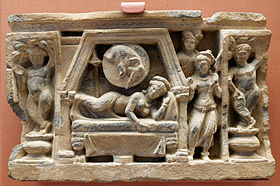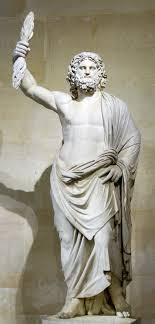 Queen Maya, the Mother of the Buddha of our age, who before his Enlightenment was known as Siddhartha Gautama, died shortly after his birth. So the future Buddha was raised by his aunt and stepmother. It is said that the womb of the Buddha’s Mother needed to remain unsullied by further pregnancies. This is similar to the belief that Mary Mother of Christ did not bear any more children after Jesus, which is held by some Christian traditions.
Queen Maya, the Mother of the Buddha of our age, who before his Enlightenment was known as Siddhartha Gautama, died shortly after his birth. So the future Buddha was raised by his aunt and stepmother. It is said that the womb of the Buddha’s Mother needed to remain unsullied by further pregnancies. This is similar to the belief that Mary Mother of Christ did not bear any more children after Jesus, which is held by some Christian traditions.
 In addition, the Buddha’s conception and birth were both miraculous, according to the legend and some Mahayana texts (such as the 44th chapter of the Gandavyuha Sutra). The Buddha was conceived when a white elephant entered Queen Maya’s right side, or, in the Sutra, light entered the Queen’s body. The Buddha was born from his Mother’s right side. The light was emanating from every pore of the body of the Bodhisattva Buddha, while he resided in the Tusita (joyous) heaven before descending to earth. This light reminds us of the golden rain form that Zeus took to reach Danaë in her cell to conceive Perseus, and links these two Indo-European patriarchal discourses.
In addition, the Buddha’s conception and birth were both miraculous, according to the legend and some Mahayana texts (such as the 44th chapter of the Gandavyuha Sutra). The Buddha was conceived when a white elephant entered Queen Maya’s right side, or, in the Sutra, light entered the Queen’s body. The Buddha was born from his Mother’s right side. The light was emanating from every pore of the body of the Bodhisattva Buddha, while he resided in the Tusita (joyous) heaven before descending to earth. This light reminds us of the golden rain form that Zeus took to reach Danaë in her cell to conceive Perseus, and links these two Indo-European patriarchal discourses.
In the Gandavyuha Sutra, Maya tells a Buddhist practitioner, who meets her in one of the exalted states he travels through, all about the Buddha’s conception. She mentions that not only the Bodhisattva Siddhartha entered her womb by means of his light, but hosts of other Bodhisattva entered her womb as well. Her body, she says, came to embrace the entire world. Moreover, Queen Maya reveals that not only did she give birth to Siddhartha Gautama, the Buddha of this world and age, but also to all the past buddhas in all other worlds, and that she will be the Mother of the future Buddha of this world, Maitreya.
The question is: how am I supposed to relate to this image of the Mother of all buddhas, past and future, whose body embraces the whole Universe? Surely I must be satisfied. This concept is so close to the idea of the Great Mother Goddess, who begets everything. And yet, this Buddhist icon is too reminiscent of patriarchal thinking to me, with too many links to other patriarchal myths.
 The central concept that makes me suspicious of these stories is the obvious unease with the body. Firstly, the woman’s body: the womb for some reason is only allowed to bear one every special child, but no others. Furthermore, in the Buddhist story the yoni is not even allowed to do her job in the baby delivery process, and so the Buddha is born from her Mother’s side. This is not unprecedented in Indo-European mythology: Zeus gives birth to two of his children: Athena and Dionysus, from his forehead and his thigh, respectively. Anything to avoid mentioning the vagina.
The central concept that makes me suspicious of these stories is the obvious unease with the body. Firstly, the woman’s body: the womb for some reason is only allowed to bear one every special child, but no others. Furthermore, in the Buddhist story the yoni is not even allowed to do her job in the baby delivery process, and so the Buddha is born from her Mother’s side. This is not unprecedented in Indo-European mythology: Zeus gives birth to two of his children: Athena and Dionysus, from his forehead and his thigh, respectively. Anything to avoid mentioning the vagina.
However, this is not all. Between the lines in the Buddha’s birth story is embarrassment with a man’s body too. Somehow conceiving by white elephant is more suitable for a buddha than conceiving by penis. This awkwardness about sex on the part of the men reminds me of a much later situation, far away from India, in tsarist Russia.
I am reading autobiographical novels by Maxim Gorky. In them, he describes the appalling spiritual state of the Russian people in the late 19th century: complete absence of education, alcoholism, and, of course, rampant misogyny. Saying that women also have “living souls” is a revolutionary act for one peasant Gorky meets. This man, incidentally, is later killed by more conservative inhabitants of his village.
Women are routinely abused by their husbands and partners. Husbands beat wives for fun, clients beat prostitutes for fun. Gorky describes how men tell crass stories about their sexual victories. At the same time, Gorky very perceptively notices a degree of shyness and embarrassment behind these men and their words. It is as if they are not quite sure why exactly they do what they do to women and if they really enjoy it.
This example shows how the patriarchal take-over confused people and how this confusion had lasted for millennia and still has not cleared up. Myths have been re-told, and even basic biological functions such as conception and birth have been disfigured to the point contrary to common sense: men giving birth out of their heads???
Women suffer as a result of these manipulations, but men suffer too, as they are not sure which role they and their sexual organs play in this whole mess. After all, if vaginas and wombs are so unclean and scary, what are men doing getting involved with those?
In Buddhism, “right vision” or understanding is one of components of the Eight-fold path to Enlightenment. This right understanding usually refers to the right understanding of the Buddhist teaching, but currently, I think it should include basic understanding of scientific truths about the world that have been discovered so far.
For instance, I think it would be beneficial to understand that humans are a very particular species of animals, in which reproduction happens in a way similar to other mammals. With the exception that humans walk upright, and thus female reproductive organs have undergone a certain transformation, which makes human birth a painful and hazardous affair.
This was an example from biology. What Buddhists can pick up from history and social sciences is that no story told in human society – mythological or religious – comes from nowhere. Each story has an origin in certain historical and cultural conditions. Each story is told by someone, to someone, with a particular goal in mind.
So when I am told that the Buddha can only be born from a womb “unsullied” by a sexual act and avoiding the birth canal, I say: “Thank you, but no thank you” to that story.
Oxana Poberejnaia is a content writer at http://content4you.org. She was an Officer of the University of Manchester Buddhist Society while studying for a PhD in Government, and has been involved in organizing the Manchester Buddhist Convention, now in its 9th year. Oxana is now exploring the Sacred Feminine through marking seasonal festivals, working with her menstrual cycle, frame drumming and shamanic journeying, while keeping the practice of Buddhist meditation. Oxana is an artist and an author. Her works can be found on her blog– http://poeticoxana.wordpress.com


Well said. Feminism places a question mark over every text and tradition. And that means we must become our own authorities.
LikeLike
Thank you, Carol, for reading and your kind comment.
LikeLike
In my understanding, the Great Mother in Buddhism, not only the mother of the historical Buddha, but the “Mother of all Buddhas,” is a personified idea with an incredibly beautiful name — in Sanskrit she is called Prajñāpāramitā — “Transcendent Wisdom.”
I like the personified idea of Prajñāpāramitā, better than a goddess, because it has more reality, that is, “transcendent wisdom” or “intuitive understanding,” is something we can practice in our own minds, and therefore become the Great Mother ourselves. Miraculous!!
LikeLike
Hello, Sarah. Thank you so much for reading and for very interesting comment. Yes, I like the idea of becoming the Great Mother myself. I think some of the tensions in the story of the Buddha’s birth, as in much of Buddhist history, comes from the differing points of view held Theravada and Mahayana Buddhism. Mahayana is best known in the West, but Theravada is the only surviving school of the original Indian Buddhism (there were more).
Prajñāpāramitā is a Mahayana concept and has links to everything that Mahayana teaches. The idea of the Buddha as a Bodhisattva who fist lived in the Tusita heaven before coming to earth with a particular mission also belongs to Mahayana. In Theravada, the Buddha was born a human (albeit miraculously) and had to walk the whole way to Enlightenment using exclusively human abilities. So these differences put different accents on the story the Buddha and his Mother.
LikeLike
I think a good story can have many interpretations and meanings, and their relevance to me can change as I change. That’s one of the things that make them so much fun. They’re not scientific or historical records, tho there might be an element of this in them. I like Sarah’s “intuitive understanding” and “transcendent wisdom”, things I think we western folks need to recover. Instead of asking/insisting (in the Roman Catholic tradition) about how many children Mary had, or if she and Joseph enjoyed some sexual intimacy, we could then ask “what is this story-teller saying about Jesus of Nazareth?” In stories of many Traditions, a person of importance, of wisdom, is often born in extraordinary circumstances. Moses, Samuel, John the Baptizer, Jesus, the Buddha, others. So instead of asking: “Is this factual?” we could be asking “What does this mean?” Maybe then we could shed some of the mis-use of story to oppress others.
LikeLike
Hello, Barbara! Thank you for reading and commenting. Yes, I agree that asking “What does it mean?” is very important.
LikeLike
See Rita Gross’s paper on this topic
Historical consciousness and traditional Buddhist narratives
http://www.internationaljournaldharmastudies.com/content/1/1/5
LikeLike
Thank you very much, Bhikshuni Trinlae. I will.
LikeLike
Thanks for this post. Anyone interested in more related to this topic can see a paper published in Exemplar a year or so back:
https://www.academia.edu/4342094/Fearlessness_v._Recklessness_A_Refutation_of_Buddhist_Gender_Essentialism_and_Chauvinism_Reconsidering_the_Marks_and_Signs_of_a_Buddha
LikeLike
Thank you, Bhikshuni Trinlae.
LikeLike
Thanks, Oxana. I learned quite a bit more than I already knew about the mythology of Buddha’s Mother here. And myths that prop up patriarchal Buddhism.
LikeLike
Thank you so much, Nancy!
LikeLike